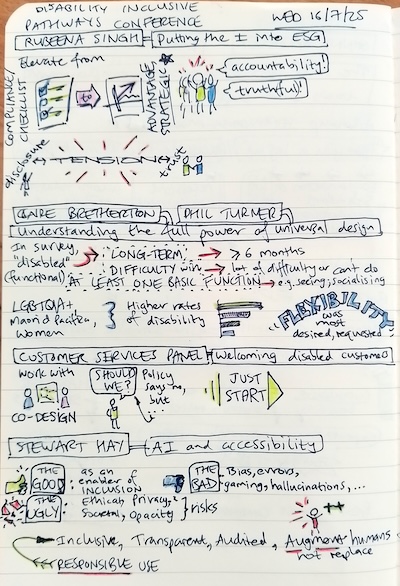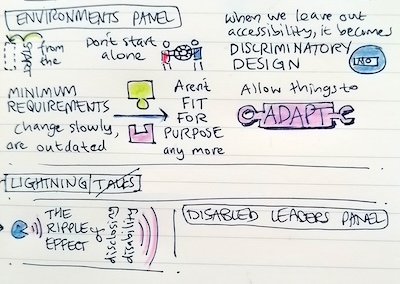Earlier this week I was at the Disability Inclusive Pathways Conference 2025 (DIPC). Here are my notes.
My top takeaways
- Lowering expectations reduces dignity
- Notice the cumulative load of many individual stressors
- Flexibility is important for accessibility
- Responsible use of AI means augmenting humans not replacing them
- The Ripple Effect of disclosing disability
My sketchnotes
DIPC Sketchnotes page 1, text version
Andy Garret - Don’t build your adjustments programme about the 0.2%
- Listen to your employees
- Have some pre-approved software
- Remove the need to qualify -> Open to everyone -> Remove the barriers to productivity
- “Are you disabled enough”?
Nerida Weller - Learning directly from disabled Colleagues
- Lowering expectations reduces dignity
- 1 in 3 households is affected by disability
- Work as a team
Senior Leaders panel - Organisational realities and what senior leaders need from us
- Supported by leadership more than driven by leadership
DIPC Sketchnotes page 2, text version
Ginny Baddeley and Tabitha Murray - The next-gen of disability employment tools and supports
- ARM-up model
- Riff on “give you a leg up”
- Accessible Recruitment Model
- Explanation of Standard Recruitment Model
- Details, e.g. parking
- Accessible Recruitment Menu
- Accommodations, existing and identified
- Accessible Recipe Book
- Hiring Team Disability Confidence
Brooke Trenwith - The Invisible Burden - Unpacking Multi-dimensional stressors
- Cumulative load + Inability to obtain relief → expectations outweigh abilities → Burnout
- Shanker Stresses: Prosocial, Biological, Emotional, Social, Cognitive
- Cognitive is most common in workplace
DIPC Sketchnotes page 3, text version
Rubeena Singh - Putting the I into ESG
- Elevate from Compliance/Checklist to Strategic Advantage
- People want Accountability, truth(ful)
- The tension between disclosure and trust
Clare Bretherton and Phil Turner - Understanding the full power of Universal Design
- In the survey, “disabled” (functional) was:
- long-term → ≥ 6 months
- difficulty with → “lot of difficulty” or “can’t do”
- at least one basic function → e.g. seeing; socialising
- LGBTQIA+, Maori & Pacifica, women - higher rates of disability
- Flexibility was most desired, requested
Customer Services Panel - Welcoming disabled customers
- Work with, Co-Design
- “Should we?” Policy says no, but …
- Just Start
Stewart Hay - AI and accessibility
- The Good → as an enabler of inclusion
- The Ugly → bias, errors, gaming, hallucination
- The Bad → ethical, privacy, societal, opacity, risks
- Responsible use: Inclusive, Transparent, Audited, Augment humans, not replace
DIPC Sketchnotes page 4, text version
Environments panel
- From the start
- Don’t start alone
- When we leave out accessibility, it becomes discriminatory design
- Minimum Requirements change slowly, are outdated → aren’t fit for purpose anymore
- Allow things to adapt
Lightning talks
- The Ripple Effect of disclosing disability



